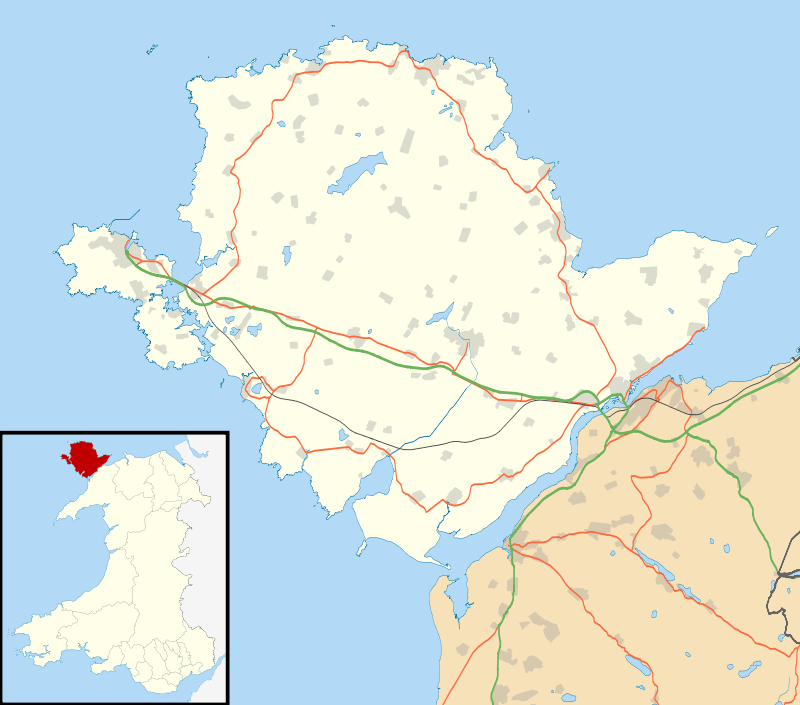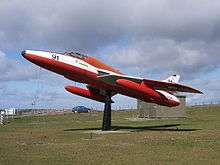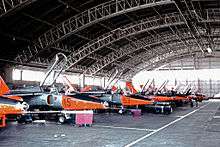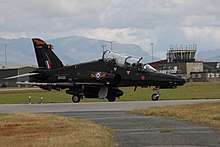RAF Valley
| RAF Valley | |||||||||
|---|---|---|---|---|---|---|---|---|---|
| Maes Awyr Môn | |||||||||
| Near Holyhead, Anglesey in Wales | |||||||||
 A RAF Hawk T1 flying over RAF Valley. | |||||||||
 | |||||||||
 RAF Valley Shown within Anglesey | |||||||||
| Coordinates | 53°14′53″N 004°32′07″W / 53.24806°N 4.53528°WCoordinates: 53°14′53″N 004°32′07″W / 53.24806°N 4.53528°W | ||||||||
| Type | Royal Air Force training station | ||||||||
| Site information | |||||||||
| Owner | Ministry of Defence | ||||||||
| Operator | Royal Air Force | ||||||||
| Controlled by | No. 22 Group (Training) | ||||||||
| Website |
www | ||||||||
| Site history | |||||||||
| Built | 1941 | ||||||||
| In use | 1941–present | ||||||||
| Garrison information | |||||||||
| Current commander | Group Captain N A Tucker-Lowe | ||||||||
| Occupants |
| ||||||||
| Airfield information | |||||||||
| Identifiers | IATA: VLY, ICAO: EGOV, WMO: 03302 | ||||||||
| Elevation | 11 metres (36 ft) AMSL | ||||||||
| |||||||||
| DAFIF[2][3] | |||||||||
Royal Air Force Valley or more simply RAF Valley (Welsh: Llu Awyr Brenhinol Y Fali) (IATA: VLY, ICAO: EGOV) is a Royal Air Force station on the island of Anglesey, Wales, and which is also used as Anglesey Airport. It provides fast-jet training using the BAE Systems Hawk and provides training for aircrew working with search and rescue.
History
World War Two
The airfield was constructed in the latter part of 1940 and opened for operations on 1 February 1941 as a Fighter Sector Station under No. 9 Group RAF with the task of providing defence cover for England's industrial north-west and shipping in the Irish Sea. Initial detachments were made by Hawker Hurricanes of 312 and 615 Squadrons. A detachment of Bristol Beaufighters of 219 Squadron provided night fighter cover.[4]

No. 456 Squadron Royal Australian Air Force (RAAF) formed at Valley on 30 June 1941 and became operational on 5 September flying Boulton Paul Defiants. By November the squadron had completely re-equipped with Beaufighter IIs, and these provided defensive night patrols over the Irish Sea until March 1943, when the unit moved away.[5]
As a result of many accidents in the Irish Sea, due to the number of training aircraft active in the area, 275 Squadron formed at Valley in October 1941, equipped with Westland Lysanders and Supermarine Walrus amphibians and these performed Air-sea rescue (ASR) missions until the unit moved away in April 1944.[6]
The runways and taxiways were extended in early 1943 and on 19 June 1943 the United States Army Air Forces (USAAF) Ferry Terminal became operational. This handled American aircraft arriving from transatlantic flights and on European sorties. Eleven Liberators of the United States Navy arrived from Iceland on 17 August. During the winter of 1943/1944, the ferry route was switched to a southerly route via the Azores and Marrakesh and on 18 February, 62 Douglas C-47s arrived from North Africa. One of Valley's busiest days was on 17 September 1944 when 99 USAAF Boeing B-17s and Liberators were ferried in from Iceland. In the middle of 1944 there was a daily transatlantic Douglas C-54 Skymaster service from Stephenville bringing airmen of all ranks, who continued their journeys to London by travelling on the LMSR Irish Mail train from Holyhead.[7]

Because of the large scale USAAF activities at Valley, RAF operations were scaled down, but on 1 November 1944, No. 1528 BAT Flight re-formed here operating Airspeed Oxford twin-engined aircraft which were used in the Beam Approach training role until moving out on 17 December 1945.[8]
RAF Valley's USAAF ferry role was reversed as soon as the European War ended and over 2,600 bombers passed through on their way back to the US for re-deployment, each carrying 20 passengers and crew. The USAAF Movement Section closed in September 1945, and in June 1947 the airfield was put on a care and maintenance basis.[9]
Postwar operations

During 1950 many improvements were made to the hangars and buildings at Valley and on 1 April 1951 No. 202 Advanced Flying School was reformed here in No. 25 Group to train fighter pilots on Vampire and Meteor jet aircraft. Vampire FB.5 and T.11 and Meteor T.7 marks were used until the unit was re-designated No. 7 Flying Training School (FTS) on 1 June 1954.[10] On 15 August 1960 the unit was renumbered No. 4 Flying Training School RAF which is still based at the airfield.[11]
The first Folland Gnat jet trainers were received on 7 November 1962 and many examples of the type were successfully operated for many years. These were supplemented by Hawker Hunters for advanced training, marks F.6 and T.7 being used. The first BAE Hawks arrived on 11 November 1976 and this type is still in use by 4 FTS.[11]
RAF Valley previously hosted the Headquarters and 'C Flight' of No. 22 Squadron, part of the RAF's Search and Rescue Force. By October 2015, the RAF SAR Force had been relieved of their responsibility by a new contractor-led operation, run by Bristow Helicopters, and the nearest SAR unit is now based at Caernarfon Airport. The RAF Operational Conversion Unit, 203(R) Squadron, was also based at Valley to train new aircrew onto the Westland Sea King HAR.3/3A, and prepare them for their SAR operations. HRH The Duke of Cambridge, second-in-line to the British Throne, was assigned to C Flight, 22 Squadron at RAF Valley, as a pilot flying the Sea King search and rescue helicopter. He finished his last shift as a pilot on Tuesday 10 September 2013.[12]
In September 2017, a project to upgrade the airfield was completed. The project involved resurfacing of the runway and link taxiways and the creation of a new section of airside perimeter road. New visual aids, aeronautical lighting and signage were installed. A hangar was refurbished to accommodate three Jupiter HT1 helicopters which will be used to train pilots from all three British armed services, as part of the UK Military Flying Training System (UKMFTS).[13] On 20 March 2018 a BAE Systems Hawk of the Red Arrows aerobatic team crashed, killing Corporal Jonathan Bayliss, an engineer.[14] The pilot, Flight Lt David Stark, survived and was treated in hospital for non-life threatening injuries.[14]
Based units

Flying and notable non-flying units based at RAF Valley.[15]
- No. 4 Flying Training School
- Headquarters No. 4 Flying School
- No. 4 Squadron – BAE Hawk T2
- Defence Helicopter Flying School
No. 38 Group (Air Combat Service Support) RAF
- No. 85 (Expeditionary Logistics) Wing
- RAF Mountain Rescue Service
- Headquarters RAF Mountain Rescue Service
- RAF Valley Mountain Rescue Team
- RAF Mountain Rescue Service
Role and operations
.jpg)
No. 4 Flying Training School (No. 4 FTS) takes RAF and Royal Navy pilots from No. 1 FTS at RAF Linton-on-Ouse and trains them to fly fast jets, prior to training on an Operational Conversion Unit. No. 4 FTS presently consists of a single squadron; No. 4 Squadron flying the BAE Hawk T2 and providing all RAF and RN fast jet student pilot training. The second squadron, 208(R) Squadron, provided legacy Hawk T1 advanced flying training and tactical weapons training until it was disbanded in June 2016. In August 2018 it was announced that No. 4 FTS will again expand to two squadrons with No. 25 Squadron being reformed in response to the RAF and RN's needs for more fast jet pilots.
RAF Mona, also on Anglesey, acts as a relief landing ground.
The base is also home to No. 202 Squadron, part of the Defence Helicopter Flying School, flying three Airbus Jupiter HT1. The squadron trains RAF and Royal Navy students on maritime and mountain flying training and those who are destined for the Royal Navy's anti-submarine warfare Merlin or Wildcat.
In future Valley will also become home to the RAF's T-6 Texan II fleet, with the intermediate fast jet training operation of No.1 FTS moving due to the planned closure of its current base at Linton-on-Ouse.
Civilian airport
The National Assembly for Wales announced on 21 February 2007 that public service obligation (PSO) flights would be launched from RAF Valley in April 2007, connecting north Wales with Cardiff International Airport.[16] A terminal facility, costing £1,500,000, was constructed at RAF Valley, named Anglesey Airport (Maes Awyr Môn), and projected to handle up to ten such PSO flights each day. The first public flight took place on 8 May 2007.
References
Citations
- ↑ Pine, L.G. (1983). A dictionary of mottoes (1 ed.). London: Routledge & Kegan Paul. p. 106. ISBN 0-7100-9339-X.
- ↑ Airport information for EGOV at World Aero Data. Data current as of October 2006.Source: DAFIF.
- ↑ Airport information for EGOV at Great Circle Mapper. Source: DAFIF (effective October 2006).
- ↑ Smith, 1981, p. 196
- ↑ Halley, 1988, p. 478
- ↑ Halley, 1988, p. 342
- ↑ Smith, 1981, p. 199
- ↑ Sturtivant, 1997, p. 139
- ↑ Smith, 1981, p. 200
- ↑ Sturtivant, 1997, p. 39
- 1 2 Sturtivant, 1997, p. 153
- ↑ "BBC News - 12th September 2013". BBC. Retrieved 24 December 2013.
- ↑ "RAF Valley's future secure for next 25 years as restoration work is completed". Royal Air Force. 26 September 2017. Retrieved 1 January 2018.
- 1 2 "Red Arrows crash: Cpl Jonathan Bayliss named as victim". BBC News. 21 March 2018. Retrieved 24 March 2018.
- ↑ "RAF Valley – Who's Based Here". Royal Air Force. Retrieved 28 July 2018.
- ↑ "North-south airline is revealed". BBC News. 21 February 2007.
Bibliography
- Halley, J.J. (1988). The Squadrons of the Royal Air Force & Commonwealth 1918-1988. Air-Britain (Historians) Ltd. ISBN 0-85130-164-9.
- Smith, D.J. (1981). Action Stations : 3 - Military Airfields of Wales and the North-West. Patrick Stephens Limited. ISBN 0-85059-485-5.
- Sturtivant, R.C. (1997). Royal Air Force Flying Training and Support Units. Air-Britain (Historians) Limited. ISBN 0-85130-252-1.
External links
| Wikimedia Commons has media related to RAF Valley. |